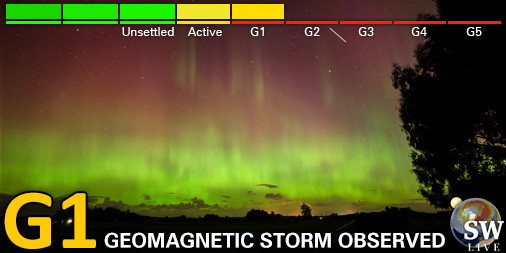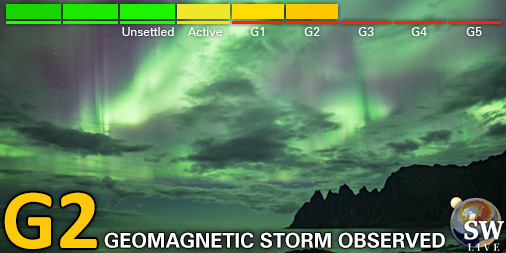Viewing archive of Thursday, 5 December 2002
Solar activity report
Any mentioned solar flare in this report has a scaling factor applied by the Space Weather Prediction Center (SWPC). Because of the SWPC scaling factor, solar flares are reported as 42% smaller than for the science quality data. The scaling factor has been removed from our archived solar flare data to reflect the true physical units.
Report of Solar-Geophysical Activity 2002 Dec 05 2200 UTCPrepared by the NOAA © SWPC and processed by SpaceWeatherLive.com
Joint USAF/NOAA Report of Solar and Geophysical Activity
SDF Number 339 Issued at 2200Z on 05 Dec 2002IA. Analysis of Solar Active Regions and Activity from 04-2100Z to 05-2100Z
Solar activity was moderate due to a single M-class
event during the period. Region 213 (N14E50) produced an impulsive
M2/2n event, with associated tenflare and Type II/IV radio sweeps,
at 04/2249 UTC. The region appears to be a relatively small sunspot
group with minor magnetic complexity, near the somewhat larger
Region 212 (N12E35) which remained quiescent during the period.
Single C- and B-class x-ray enhancements were also observed without
optical correlation later in the period, but otherwise the x-ray
emissions from the sun have remained relatively flat. Two new
regions were numbered today: 214 (N12W27) and 215 (S18E74). The
latter appears to be a return of old Region 191 (S18, L=203) but
limb proximity prevents detailed analysis.
IB. Solar Activity Forecast
Solar activity is expected to be
predominantly low, with an increasing trend in chances for isolated
moderate flare activity over the course of the next three days.
IIA. Geophysical Activity Summary 04-2100Z to 05-2100Z
The geomagnetic field was quiet to unsettled. Flux levels for
greater than 2 MeV electrons at geosynchronous orbit were observed
to briefly exceed threshold for high values around the time of local
satellite noon.
IIB. Geophysical Activity Forecast
The geomagnetic field is
expected to be quiet to unsettled through day two of the forecast
period, with a trend toward more active conditions by day three, due
to expected coronal hole effects. Greater than 2 MeV electron flux
at geosynchronous orbit is expected to be below the high value
threshold for the period.
III. Event Probabilities 06 Dec to 08 Dec
| Class M | 30% | 30% | 35% |
| Class X | 01% | 01% | 01% |
| Proton | 01% | 01% | 01% |
| PCAF | green | ||
IV. Penticton 10.7 cm Flux
Observed 05 Dec 149 Predicted 06 Dec-08 Dec 160/170/175 90 Day Mean 05 Dec 169
V. Geomagnetic A Indices
Observed Afr/Ap 04 Dec 007/012 Estimated Afr/Ap 05 Dec 009/013 Predicted Afr/Ap 06 Dec-08 Dec 008/012-012/015-018/020
VI. Geomagnetic Activity Probabilities 06 Dec to 08 Dec
| A. Middle Latitudes | |||
|---|---|---|---|
| Active | 20% | 25% | 35% |
| Minor storm | 01% | 05% | 10% |
| Major-severe storm | 01% | 01% | 01% |
| B. High Latitudes | |||
|---|---|---|---|
| Active | 20% | 30% | 40% |
| Minor storm | 05% | 10% | 15% |
| Major-severe storm | 01% | 01% | 05% |
All times in UTC
Latest news
Latest forum messages
Incoming & Unnumbered Active Regions 1662Unspecified geomagnetic activity 2222AR4048 114New satellites - Proba-3, PUNCH, SWFO-L1, GOES-U/19 36Filaments and prominences 750
More topicsSupport SpaceWeatherLive.com!
A lot of people come to SpaceWeatherLive to follow the Sun's activity or if there is aurora to be seen, but with more traffic comes higher server costs. Consider a donation if you enjoy SpaceWeatherLive so we can keep the website online!

Latest alerts
10:00 UTC - Hemispheric Power Index
The OVATION model predicts the Hemispheric Power Index to reach 78GW at 10:32 UTC
04:15 UTC - Geomagnetic activity
Minor G1 geomagnetic storm (Kp5) Threshold Reached: 04:05 UTC
03:15 UTC - Geomagnetic activity
Moderate G2 geomagnetic storm (Kp6) Threshold Reached: 02:59 UTC
01:00 UTC - Geomagnetic activity
Minor G1 geomagnetic storm (Kp5) Threshold Reached: 00:51 UTC
Friday, 4 April 2025
23:30 UTC - Geomagnetic activity
Minor G1 geomagnetic storm (Kp5) Threshold Reached: 23:17 UTC
Space weather facts
| Last X-flare | 2025/03/28 | X1.1 |
| Last M-flare | 2025/04/01 | M2.5 |
| Last geomagnetic storm | 2025/04/04 | Kp5+ (G1) |
| Spotless days | |
|---|---|
| Last spotless day | 2022/06/08 |
| Monthly mean Sunspot Number | |
|---|---|
| March 2025 | 134.2 -20.4 |
| April 2025 | 148 +13.8 |
| Last 30 days | 130.9 -15.2 |






